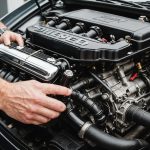When it comes to British sports cars, their sleek designs, powerful engines, and razor-sharp handling often take center stage. However, to truly unlock their potential, a high-performance braking system is essential. Whether you’re looking to improve your car’s stopping power for daily driving or aiming to shave seconds off your lap time at the track, upgrading your brakes can make a world of difference. This article will guide you through the process step-by-step, ensuring you have all the information you need to successfully install a high-performance braking system in your British sports car.
Understanding the Importance of High-Performance Brakes
Upgrading your car’s braking system might sound intimidating, but the benefits far outweigh the initial complexity. High-performance brakes aren’t just about stopping faster—they also improve your car’s overall handling, safety, and longevity. Traditional brakes can struggle under the intense conditions that sports cars often find themselves in, leading to brake fade and reduced efficiency over time.
Also to see : What is the best way to upgrade the suspension system on a British family estate car?
High-performance braking systems are designed to withstand greater heat and pressure, offering consistent performance and reliability. These systems usually feature larger calipers, better brake pads, and higher quality rotors. In addition, a well-designed system will dissipate heat more efficiently, reducing the chances of brake fade during prolonged use.
Selecting the Right Components
When it comes to choosing components for your high-performance braking system, compatibility is key. British sports cars come in a wide variety, from the classic Aston Martin to the modern Lotus, and each has its own unique requirements. Here are the critical parts you’ll need to consider:
Also to discover : What are the proper steps to detail the interior of a British luxury vehicle?
Brake Calipers
The brake caliper is the part of the braking system that squeezes the brake pads against the rotor, creating the friction necessary to slow down the car. High-performance calipers are usually made from lighter materials like aluminum and often feature multiple pistons for more even pressure distribution. Look for calipers that are specifically designed for your car model to ensure a perfect fit.
Brake Pads
Brake pads are crucial for creating the friction needed to stop your car. High-performance brake pads are made from advanced materials like ceramic or semi-metallic compounds, which offer better heat resistance and longer life. Make sure to select pads that are compatible with your chosen calipers and driving style.
Brake Rotors
Brake rotors, or discs, are another essential component of your braking system. High-performance rotors are typically ventilated and may feature drilled holes or slots to improve heat dissipation and water dispersion. These features are especially important for track driving, where the brakes are subjected to extreme conditions.
Brake Lines
Upgrading to stainless steel brake lines can also improve braking performance. Unlike rubber lines, which can expand under pressure, stainless steel lines provide a more consistent brake feel and reduce the chances of brake fluid boiling under heavy use.
Preparation and Tools Needed
Before diving into the installation process, it’s essential to gather all the necessary tools and prepare your workspace. Having everything on hand will make the job smoother and more efficient.
Tools and Equipment
- Jack and jack stands: For safely lifting and securing your car.
- Wrenches and sockets: A variety of sizes to fit different bolts and nuts.
- Torque wrench: To ensure all bolts are tightened to the manufacturer’s specifications.
- Brake bleeder kit: For removing air from the brake lines.
- Brake fluid: High-performance fluid that matches your new system’s requirements.
- Brake cleaner: To remove any contaminants from the components.
- Protective gear: Gloves and safety glasses to protect yourself during the installation.
Workspace Preparation
Ensure you have a clean, well-lit workspace with plenty of room to move around your vehicle. Prepare a solid, flat surface where you can safely lift your car. Lay out all your tools and components in an organized manner to avoid any confusion during the installation.
Step-by-Step Installation Guide
With everything prepared, you can now proceed with the installation. Follow these steps closely to ensure a successful upgrade.
Step 1: Lift the Car and Remove the Wheels
Use the jack to lift the car and secure it with jack stands. Ensure the car is stable before proceeding. Remove the wheels to access the braking system.
Step 2: Remove the Old Brake Components
Start by removing the brake calipers, pads, and rotors. Be careful to disconnect any brake lines without causing damage. Use the brake cleaner to clean the mounting surfaces.
Step 3: Install the New Brake Components
Mount the new brake rotors first, ensuring they are seated correctly. Next, install the new calipers, making sure they are aligned and securely fastened. Insert the new brake pads into the calipers.
Step 4: Connect the New Brake Lines
Attach the stainless steel brake lines to the calipers and the car’s brake system. Ensure all connections are tight to prevent any leaks.
Step 5: Bleed the Brakes
Using the brake bleeder kit, remove any air from the brake lines. This step is crucial for ensuring a firm and responsive brake pedal.
Step 6: Refill Brake Fluid
Top up the brake fluid reservoir with high-performance brake fluid. Check for any leaks and ensure the fluid level is correct.
Step 7: Reinstall the Wheels and Lower the Car
Once everything is in place and secure, reinstall the wheels. Carefully lower the car back to the ground and perform a final check to ensure everything is tight and in order.
Testing and Final Adjustments
After completing the installation, it’s crucial to test the new braking system to ensure it performs as expected. Here are the steps to follow:
Bed-In the Brake Pads
Most high-performance brake pads require a bed-in procedure to optimize their performance. This usually involves a series of controlled stops from increasing speeds to gradually transfer a layer of pad material onto the rotors. Follow the manufacturer’s instructions for the best results.
Check for Leaks and Test Brake Feel
Take your car for a short test drive in a safe area to check for any leaks and to assess the brake feel. The pedal should feel firm and responsive. If the brakes feel spongy, you may need to re-bleed the brake lines to remove any remaining air.
Monitor Performance
Over the next few days, monitor the performance of your new braking system. Pay attention to any unusual noises or changes in brake feel. It’s always a good idea to periodically check the brake fluid level and inspect the components for any signs of wear or damage.
Installing a high-performance braking system in your British sports car is an investment that pays off in spades. Not only will you experience improved stopping power and enhanced safety, but you’ll also enjoy a more connected and responsive driving experience. By following the steps outlined in this article, you can successfully upgrade your braking system and unlock your car’s true potential.
Whether you’re an enthusiast looking to optimize your car for track days or simply want the peace of mind that comes with superior braking performance, this upgrade is well worth the effort. So, gather your tools, prepare your workspace, and get ready to experience the incredible difference a high-performance braking system can make.











